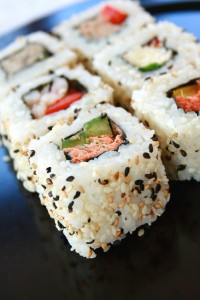As I’m sure everyone knows, there’s a big shake-up happening in the world of traditional journalism. Print newspapers are shrinking — both their staff and their printed size — sending many journalists to the highly competitive world of online publishing.
 Online publishing is fairly competitive, because in many writers’ minds — in order to get your article read, you need to be the first one to break the story and publish it online. In theory, the idea that you need to “get there first” sounds no different than if you worked for a brick-and-mortar newspaper. In practice, “getting there first” without having the time to vet your sources or discover whether or not a blog is credible may be questionable because of the way the internet functions.
Online publishing is fairly competitive, because in many writers’ minds — in order to get your article read, you need to be the first one to break the story and publish it online. In theory, the idea that you need to “get there first” sounds no different than if you worked for a brick-and-mortar newspaper. In practice, “getting there first” without having the time to vet your sources or discover whether or not a blog is credible may be questionable because of the way the internet functions.
When someone writes for an online news publisher, that content gets syndicated in hundreds of places and is also picked up by the search engines. With the online space, publishing a news piece is a lot like throwing a stone into a pond and then watching the ripple effect. You’ll not only “see” when others are reading your content through web analytics, you’ll also know when someone is “talking” about your article through the comments, other blogs and places like Twitter, Facebook, etc.
If a print newspaper makes a mistake, they can print a retraction. If you make a mistake online, you can edit your original article. Unfortunately, the timing of your edit may take place after others have already commented on and spread the wrong information. In my mind, this means that writers need to be extraordinarily careful when posting online “news” content especially since courts are considering libel cases for blogs. Here is a link to the EFF overview of the Online Defamation Law. Remember, internet law is very “young” and there are a lot of rulings still in development. Just recently, the FCC started cracking down on online testimonials. (FTC Concludes Case Against Marketers of Xenadrine EFX)
Besides legal issues, there’s another reason why getting your information correct is so important: your news article is archived on the web. With print, you have a situation where many newspapers get recycled or tossed. It’s difficult to find older articles unless you go to the “Morgue” or a library to look them up. With the web, natural search (e.g. typing in what someone wants to find in a search engine) is an instantaneous reference system that doesn’t necessarily order content by the date of publication. The result? When a reader wants to reference old content that’s easily accessible, sometimes rumors (like the Prop 8 Overturned Rumor on Twitter) can ensue.
Update: Less than a day after I posted these thoughts the very same effect happened again, this time with the Iran elections. Whether it was due to the chaos or the speed at which information was flying around, in addition to “good” information, several old pictures of violence in Afghanistan were passed around on Twitter as if they happened that day in Iran. CNN and the major news networks did not “jump” on the reporting, which spurred comments of “CNNfail.” I didn’t (and won’t) pull examples of folk who spread bad information around. The info was flying so fast, there seemed to be thousands of micro-blogging posts an hour. I honestly believe this was another case where people didn’t read or visit the links they were sharing.
Another reason why sources are so important, is because I’m also seeing that citizen journalism is becoming more and more popular. “Citizen” journalism in my mind, is when a writer who is not affiliated with a news publication breaks a story through their personal websites. Savvy journalists need to keep this in mind, because some (not all) citizen journalists do not check their sources. This is why search — e.g. searching keywords in multiple different ways and word orders — is a journalist’s best friend. As I’ve mentioned earlier, the internet is full of self-titled experts who may (or may not) have a background in the subject matter they claim to have knowledge in. In this case, you are the expert in your field, so don’t be afraid to take a few extra minutes to offer relevant and accurate content.
Finally, the last reason why you want to be careful about “getting there first” is because your reputation is at stake. When a reporter makes a mistake online, the drama that ensues may blow over quickly. However, your online reputation may be affected in the long-term because when people look for your name, they’ll find that “typed” drama days, weeks and months after the fact. (For more information, read the NYT article about How to Manage Your Reputation Online.)
As a journalist, you are the expert in writing news, but there may be some simple ways you can “get there first” and ensure your reputation is protected:
- Understand SEO – Whether you visit Google Webmaster Central for an SEO starter guide or follow Search Engine Land, read up on search engine optimization and learn how it affects your web copywriting. I recommend keeping up on the topic because search is constantly changing.
- Specialize in a Few Topics – By embracing a limited amount of topics, you can structure your articles and make a name for yourself in that particular area. It is easier to “get there first” if you know your source material well and can pull from an established list of sources.
- Be Clear About Rumors vs. Facts – If you’re still on deadline and can’t verify one of the sources, I’d still write the article but be very clear what you weren’t able to verify by citing rumors and facts. That way, if a reader misinterprets your article your bases are covered because you’ve written, “According to an unverified source…” etc.
- Timestamp or Date your Edits When Appropriate – Many articles also “update” the original with an “edit” that offers clarification or fixes after the fact. I recommend dating these edits in your copy, to prevent confusion. This might apply to “breaking” news stories that are constantly evolving.
- Write for Credible Publications – The other side to online journalism, is to find a publication that is reputable. Don’t be afraid to turn down assignments if you feel it might hurt your reputation.
If you’re writing online, don’t be afraid to monitor your online reputation, too. In my mind, Googling yourself is no longer an act of vanity because your employers, readers and friends and family are doing the exact, same thing. By applying simple edits and SEO tactics, you can still “get there first” without damaging your reputation and ensure you’re following journalism’s time-tested ethics.
 Wanted to make sure I had lunch for tomorrow that consisted of something other than soup, so shared salad and homemade mac-n-cheese. The mac-n-cheese recipe I have comes from the book pictured here: The Vegetarian Family Cookbook by Nava Atlas. I have to say that I get a lot of use out this particular cookbook, because there are recipes in here my meat eater will gladly indulge in. There are two recipes for mac-n-cheese here with variations for vegan vs. not. One is a milk-based sauce, the other is tofu-based. I haven’t tried the tofu-based one yet, but am keeping that as an option since I have issues with cooking tofu.
Wanted to make sure I had lunch for tomorrow that consisted of something other than soup, so shared salad and homemade mac-n-cheese. The mac-n-cheese recipe I have comes from the book pictured here: The Vegetarian Family Cookbook by Nava Atlas. I have to say that I get a lot of use out this particular cookbook, because there are recipes in here my meat eater will gladly indulge in. There are two recipes for mac-n-cheese here with variations for vegan vs. not. One is a milk-based sauce, the other is tofu-based. I haven’t tried the tofu-based one yet, but am keeping that as an option since I have issues with cooking tofu.
 It’s no secret that I’m a big fan of sushi, but I’m also a fan of eating right. So I decided over the weekend to start on a 30-day excursion that I call “My Pescatarian Adventures.” Most vegetable-based (with the occasional sushi goodness) this is a shift for me from the chicken/carb/vegetable means I’ve been eating. I’d like to share with you some of the things I’ve learned. For those of you who aren’t interested in these adventures, I’m going to start off each post with “Day + Number” so you can skip on by if you’re not up to reading these. I’ll still keep posting about writing; this is something “new.”
It’s no secret that I’m a big fan of sushi, but I’m also a fan of eating right. So I decided over the weekend to start on a 30-day excursion that I call “My Pescatarian Adventures.” Most vegetable-based (with the occasional sushi goodness) this is a shift for me from the chicken/carb/vegetable means I’ve been eating. I’d like to share with you some of the things I’ve learned. For those of you who aren’t interested in these adventures, I’m going to start off each post with “Day + Number” so you can skip on by if you’re not up to reading these. I’ll still keep posting about writing; this is something “new.” Online publishing is fairly competitive, because in many writers’ minds — in order to get your article read, you need to be the first one to break the story and publish it online. In theory, the idea that you need to “get there first” sounds no different than if you worked for a brick-and-mortar newspaper. In practice, “getting there first” without having the time to vet your sources or discover whether or not a blog is credible may be questionable because of the way the internet functions.
Online publishing is fairly competitive, because in many writers’ minds — in order to get your article read, you need to be the first one to break the story and publish it online. In theory, the idea that you need to “get there first” sounds no different than if you worked for a brick-and-mortar newspaper. In practice, “getting there first” without having the time to vet your sources or discover whether or not a blog is credible may be questionable because of the way the internet functions.